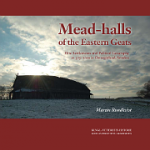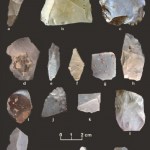archaeology
Here's my talk about the Mead-halls book, from the Gothenburg Book Fair, 23 September. It's in Swedish, the background noise is awful and I had a pretty poor voice that day. But anyway.
Swedish academic archaeology has a few hard-core post-modernists. Their attitude to the discipline tends to be meta-scholarly (they study people relating to the past rather than the remains of the past), radically knowledge-relativist (they reject rationalist science with its aim to gain cumulative objective knowledge about what the world is like) and influenced by Continental philosophy, sociology and "critical theory". My attitude to these colleagues is such that if I were the one who decided who gets research funding and teaching jobs, they would all be doing fieldwork on highway projects…
Wednesday 5 Oct. 17:00. About Fisksätra before the 1970s housing development. Fisksätra shopping centre, HAMN project office.
Thursday 13 Oct. 10:00. About Bronze Age sacrificial sites. Uppsala, Engelska parken, Thunbergsvägen 3, Dept of Archaeology.
Monday 17 Oct. 18:30. About pseudoarchaeology. Stockholm, KTH, Lindstedtsvägen 5, lecture hall D2, Swedish Skeptics.
Thursday 27 Oct. 14:00. About the late-1st millennium aristocracy. Norrköping, Saltängsgatan 7, Senioruniversitetet.
Thursday 3 Nov. 14:30. About the new media. Kristiansand, Vestre Strandgate 7, Radisson Blue Caledonien…
Uppåkra near Lund is Scandinavia's largest 1st millennium settlement site and may (for some definitions of "town") have been the first town north of Germany. Its finds are absolute top-quality and occur in vast numbers. For many object types, there are now more specimens from Uppåkra only than we used to have from all of Sweden. I've had the pleasure of working with some 7th/8th century brooch types from the site, and I always read news about the ongoing investigations at Uppåkra with great interest.
Now they've found something unique again. Rolf Petré calls it a mount, possibly for a…
The top official in charge of protecting and making accessible the archaeological record in Sweden is titled Riksantikvarie, "Antiquarian of the Realm". In English, this title is usually translated as "Custodian of Ancient Monuments". How should a person act in practice as custodian of ancient monuments?
Everybody understands that you need to keep people from damaging sites & monuments through digging, ploughing, dynamiting, covering, and graffiti. But you can't just declare a site out-of-bounds and leave it to its own devices: pretty soon it will become so overgrown that it is…
The Mesolithic is the period between deglaciation and the introduction of agriculture in Europe (up to about 4000 cal BC in my parts). Within Swedish research into this period in recent years, no single site has been able to compete with the small town of Motala in Ãstergötland county. Located at a series of rapids on the main waterway from Lake Vättern to the Baltic, the spot has always been important for fishers and travellers. Its Mesolithic record has gained the limelight thanks to major railroad construction in an area with waterlogged sediment that preserves organics. Thus any number…
Here's a quick look at the most recent windfall of popular archaeomags that has reached my big black mailbox. I've decided to terminate a few of the complimentary subscriptions, so these rundowns will be shorter and/or less frequent in the future. If you want, Dear Reader, you can check back at the five instalments I've written since late December: 23 Dec - 27 Jan - 15 March - 30 April - 14 June.
To me, the high point of Archaeology Southwest #25:2 (spring '11) are two aerial photographs of the Gran Quivira / San Buenaventura mission pueblo in central New Mexico (pp. 6-7). Here is a major…
Those who want hard copy or are unwilling to wait six months for the free PDF can now order my Mead-halls book on-line for SEK 180 / U$D 27 / â¬20 / £17 plus postage.
Rundkvist, Martin. 2011. Mead-halls of the Eastern Geats. Elite Settlements and Political Geography AD 375-1000 in OÌstergoÌtland, Sweden. Kungl. Vitterhets Historie och Antikvitets Akademien (KVHAA), Handlingar, Antikvariska serien 49. Stockholm 2011. 165 pp. ISBN 978-91-7402-405-0.
Abstract
The Swedish province of OÌstergoÌtland has long been recognised as one of the 1st millennium's political hot spots. Splendid single finds, though never before surveyed comprehensively, offer a rough idea of where elite settlements might be sought. But not one of the ostentatious manorial buildings…
In 2009, geologist Nils Axel Mörner and Bob G. Lind (and a distinguished third author who was not consulted about having his name on the publication) had a paper published in Geografiska Annaler about the Ravlunda 169 cemetery. This was an outcome of the pair's unauthorised digging at the site in 2007. The paper is a mess and shouldn't have been accepted. Tellingly, the topic is archaeology and quaternary geology, while none of the authors is an archaeologist and the journal is about geography.
Now Alun Salt and I have replied to Mörner & Lind's paper, also in Geografiska Annaler. At…
Scandinavian Bronze Age art features a number of motifs having to do with the movement of the sun through the heavens during the day and the underworld during the night. Here on Aard, we've previously seen a recently found sun-chariot rock carving, which most likely depicts a wheeled bronze model. But more commonly, there's a horse pulling the sun's disc across the sky without the benefit of wheels. This motif is known from several rock art sites on Sweden's west coast.
Awesome rock art surveying team Roger Wikell, Sven Gunnar Broström and Kenneth Ihrestam have recently found the first two…
I'm a single dad now for two weeks while my wife's in China shooting interviews for a documentary series.
Aard's been getting a lot of comment spam lately, and the filter isn't working properly, so I've turned on comment moderation.
After digging in that cave I did four hours of metal detecting at the Lilla Härnevi hoard site because it has been ploughed and harrowed since April when we were there in force. Only one semi-worthwhile metal find: one of those fyrk coins of Queen Christina's. Also two pieces of knapped imported flint, and Magdalena found a grindstone. No hoard bits.
I bought…
Few Swedish caves contain any known archaeology, and those that do mainly feature Mesolithic and Neolithic habitation layers. The Pukberget ("Devil's Mountain") cave near Enköping is a rare exception. In the mid-20th century a fox hunter crawled into the cave and felt his way around. His questing hands encountered something on a ledge which he put in his coat pocket. When he came out into the open air, he saw that he'd found a bronze spearhead and a horse tooth. Both are now in the Museum of National Antiquities. The spearhead dates from the Late Bronze Age, about 700 BC.
I've spent the…
Feels like I've got a bit too much on my plate right now. Tonight's boardgame night, so I need to get everything packed up before dinner. "Pack up what?", I hear you say. Well, I'm spending the next couple of days digging & sieving test pits in a cave near Enköping where a Bronze Age spearhead has been found. While I'm there I'm also going to do half a day or so of renewed metal detecting at one of the hoard sites that proved non-productive back in April. The farmer has ploughed and harrowed the spot so new stuff may have emerged up into detector reach. During fieldwork I also have to…
I always enjoy reading Current Archaeology, both for the quality content and for the simple fact that it's about the UK, an area whose archaeology I have some little insight into and a great deal of interest in. (My interest hinges largely on the many similarities with the Swedish record and my knowledge of the language.)
The cover story of the current issue (#257, August) treats contract excavations at a graveyard near the original Bedlam mental hospital in London, or the priory of St Mary of Bethlehem as it was originally known when founded in 1247. The burials actually don't have much to…
Charles Higham remembers his first digs in France, at age 16, in 1956.
[My brother] Richard and I began in the Grotte de L'Hyene. This was a tunnel complex that contained the occasional Neanderthal artefact. It was dark and cold, and at lunchtime we crawled out into the welcome summer warmth for food, liberally enhanced with the local red wine. All then retired for a much needed siesta, to be awakened for further digging by the sound of Mongolian bagpipes played by Professor Leroi-Gourhan, 'Le Patron'.
Current World Archaeology 48 (Aug/Sept 2011), p. 14
It's that time of the year again when little usually happens and Sweden's loudest and most aggressive amateur archaeologist likes to get in the news. As mentioned here before, Bob G. Lind has managed to get my otherwise respected colleague Wladyslaw Duczko to join him and dowsing-rod geologist N-A. Mörner for some fieldwork near a lovely standing-stone ship in Scania, the famous Ales stenar, built in the 7th century AD. Duczko's involvement solved the problem previously alluded to here, that when local bodies give Bob funding for fieldwork, they're betting on a horse that can't actually get…
With Julia spending the summer and most of the fall in The Republic of Georgia, I've been thinking about various political and historical aspects of that country, and one of the things that is claimed to be true is that wine was first invented there.
Recently, someone asked me (always ask the archaeologist esoteric stuff like this) where wine was first invented. And, recently, we scored some Concord Grapes, which are native to North America (presumably thanks to some bird a long time ago) as opposed to most grapes, and which provide the roots for most (nearly all?) wine grape stock. And, a…
Butter Milk Creek is a Texas archaeological site and an archaeological complex located rather symbolically a couple of hundred miles downstream from the famous Clovis site in New Mexico. It is the most recently reported alleged manifestation of a "pre-Clovis" archaeological presence. The most important thing about this site is probably this: It is well dated (though the dates need to be independently verified or otherwise run through the gauntlet of criticism dates of important sites are always subjected to) and there are a lot of artifacts at the site. The importance of the number of…
Since the autumn of 2009, I've spent most of my research efforts studying sacrificial finds in the Bronze Age local landscape. I was thus pleasantly surprised (though a little disappointed because I missed the whole thing) when I learned that there had been a symposium on the theme "Sacrificial finds in the Late Bronze Age local landscape" at the museum in Viborg, Jutland, in March last year. Recently, only about a year after the event, a fine proceedings volume (104 pp., A4 format, 2-column text, colour printing) was published, and I was kindly sent a copy for review here on Aard.
The volume…

